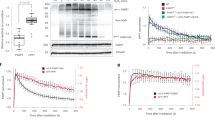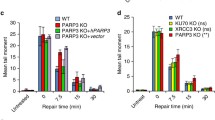Abstract
The enzymes poly(ADP-ribose)polymerase and poly(ADP-ribose) glycohydrolase may cooperate to drive a histone shuttle mechanism in chromatin. The mechanism is triggered by binding of the N-terminal zinc-finger domain of the polymerase to DNA strand breaks, which activates the catalytic activities residing in the C-terminal domain. The polymerase converts into a protein carrying multiple ADP-ribose polymers which displace histones from DNA by specifically targeting the histone tails responsible for DNA condensation. As a result, the domains surrounding DNA strand breaks become accessible to other proteins. Poly(ADP0ribose) glycohydrolase attacks ADP-ribose polymers in a specific order and thereby releases histones for reassociation with DNA. Increasing evidence from different model systems suggests that histone shuttling participates in DNA repairin vivo as a catalyst for nucleosomal unfolding.
Similar content being viewed by others
References
Althaus FR and Richter C: ADP-Ribosylation of Proteins: Enzymology and Biological Significance. Springer-Verlag, Berlin Heidelberg New York Tokyo, 1987, 237 pp
De Murcia G, Huletsky A and Poirier GG: Review: Modulation of chromatin structure by poly(ADP-ribosyl)ation. Biochem Cell Biol 66:620635, 1988
Jacobson MK and Jacobson EL (eds): ADP-ribose Transfer Reactions: mechanisms and Biological Significance. Springer, New York, 1989, 527 pp
De Murcia G, Ménissier-De Murcia J and Schreiber V: Poly(ADP-ribose)polymerase: molecular biological aspects. BioEssays 13:455–462, 1991
Poirier GG and Moreau P (eds): ADP-Ribosylation Reactions. Springer, New York, 1992, 410 pp
Althaus FR, Collinge M, Loetscher P, Mathis G, Neigeli H, Panzeter P and Realini C: The poly ADP-ribosylation system of higher eukaryotes: How can it do what: In: G. Obe and A.T. Natarajan (eds.). Chromosomal Aberrations—Basic and Applied Aspects. Springer, Berlin Heidelberg, 1989, pp 22–30
Realini C and Althaus FR: Histone shuttling by poly ADP-ribosylation, J. Biol Chem 267:18858–18865, 1992
Althaus FR: Poly ADP-ribosylation: A histone shuttle mechanism in DNA excision repair. J Cell Science 102:663–670, 1992
Benjamin RC and Gill DM: ADP-ribosylation in mammalian cell ghosts. Dependence of poly(ADP-ribose)synthesis on strand breakage in DNA. J Biol Chem 255:109493–10501, 1980
Benjamin RC and Gill DM: Poly(ADP-ribose)synthesisin vitro programmed by damaged DNA. A comparison of DNA molecules containing different types of strand breaks. J Biol Chem 255:10502–10508, 1980
Ménissier-De Murcia J, Molinete M, Gradwohl G, Simonin F and De Murcia G: Zinc-binding domain of poly(ADP-ribose)polymerase participates in the recognition of single strand breaks on DNA. J Mol Biol 210:229–233, 1989
Mazen A, Ménissier-De Murcia J, Molinete M, Simonin F, Gradwohl G, Poirier GG and De Murcia G: Poly(ADP-ribose)polymerase: a novel finger protein. Nucl Acids Res 17:4689–4598, 1989
Gradwohl G, Mènissier-De Murcia J, Molinete M, Simonin F, Koken M., Hoeijmakers JHJ and De Murcia G: The second zinc-finger domain of poly(ADP-ribose)polymerase determines specificity for singlestranded breaks in DNA. Proc Natl Acad Sci USA 87:2990–2994, 1990
Ikejima M, Noguchi S, Yamashita R, Ogura T, Sugimura T, Gill DM and Miwa M: The zinc fingers of human poly(ADP-ribose)polymerase are differentially required for the recognition of DNA breaks and nicks and the consequent enzyme activation. J Biol Chem 265:21907–21913, 1990
Friedberg EC: DNA Repair. W. H. Freeman, New York, 1985, 614 pp
Lambert MW and Laval J (eds), DNA repair mechanisms and their biological implications in mammalian cells. Plenum Press, New York, 1989, 667 pp
Simonin F, Höfferer L, Panzeter PL, Muller S, de Murcia G and Alunaus FR: The carboxyl-terminal domain of human poly(ADPribose)polymerase. Overproduction inEscherichia coli, large scale purification, and characterization. J Biol Chem 268:13454–13461, 1993
Cohen JJ and Berger NA: Activation of poly(adenosine diphosphate ribose)polymerase with UV irradiated and UV endonuclease treated SV40 minichromosomes. Biochem Biophys Res Commun 98:268–274, 1981
Berger NA, and Sikorski GW, Poly(adenosine diphosphoribose)synthesis in ultraviolet-irradiated xeroderma pigmentosum cells reconstituted with micrococcus luteus UV endonuclease. Biochemistry 20:3610–3614, 1981
McCurry LS and Jacobson MK: Poly(ADP-ribose)synthesis following DNA damage in cells heterozygous or homozygous for the Xeroderma pigmentosum genotype. J Biol Chem 256:551–553, 1981
Cohen JJ, Catino DM, Petzold SJ and Berger NA: Activation of poly(adenosine diphosphate ribose)polymerase by SV40 minichromosomes: Effects of deoxyribonucleic acid damage and histone Hl. Biochemistry 21:493–4940, 1982
Ogata N, Ueda K, Kawaichi M and Kayaishi O: Poly(ADP-ribose) synthetase, a main acceptor of poly(ADP-ribose) in isolated nuclei. J Biol Chem 256:4135–4137, 1981
Adamietz P: Poly(ADP-ribose)synthase is the major endogenous nonhistone acceptor for poly(ADP-ribose) in alkylated rat hepatoma cells. Eur J Biochem 169:365–372, 1987
Desmarais Y, Ménard L, Lagueux J and Poirier GG: Enzymoloogical properties of poly(ADP-ribose)polymerase: characterization of automodification sites and NADase activity. Biochem Biophys Acta 1078:179–186, 1991
Ferro AM and Olivera BM: Poly(ADP-ribosylation)in vitro. Reaction parameters and enzyme mechanism. J Biol Chem 257:7808–7813, 1982
Zahradka P and Ebisuzaki K: A shuttle mechanism for DNA-protein interactions. The regulation of poly(ADP-ribose)polymerase. Bur J Biochem 127:579–585, 1982
De Murcia G, Jongstra-Bilen J, Ittel ME, Mandel P and Delain E: Poly(ADP-ribose)polymerase automodification and interaction with DNA: electron microscopic visualization. EMBO J 2:4543–548, 1983
Gaudreau A, Ménard L, De Murcia G and Poirier GG: Poly(ADP-ribose) accessibility to poly(ADP-ribose)glycohydrolase activity on poly (ADP-ribosyl)ated nucleosomal proteins. Biochem Cell Biol 64: 146–153, 1986
Naegeli H Loetscher P and Althaus FR: Poly ADP-ribosylation of proteins. Processivity of posttranslational modification. J Biol Chem 264:14382–14385, 1989
Naegeli H and Althaus FR: Regulation of poly(ADP-ribose)polymerase. Histone-specific adaptations of reaction products. J Biol Chem 266: 10596–10601, 1991
Malanga M and Althaus FR: Poly(ADP-ribose) molecules formed during DNA repairin vivo. J Biol Chem, in press, 1994
Malanga M and Althaus FR: Effect of DNA damage on the numbers and size distributions of ADP-ribose polymersin vivo. Experientia 49:2, 1993
Panzeter PL, Realini CA and Althaus FR: Poly(ADP-ribose) molecules formed during DNA repairin vivo. J Biol Chem, in press, 1994
Alvarez-Gonzalez R and Althaus FR: Poly (ADP-ribose) catabolism in mammalian cells exposed to DNA-damaging agents. Mutat Res 218: 67–74, 1989
Hatakeyama K, Menoto YU, Ueda K, Hayaishi I: Purification and characterization of poly(ADP-ribose)glycohydrolase. Different modes of action on large and small poly(ADP-ribose). J Biol Chem 261: 14902–14911, 1986
Ikejima M and Gill DM: Poly(ADP-ribose) degradation by glycohydrolase starts with an endonucleolytic incision. J Biol Chem 263:11037–11040, 1988
Mathis G and Althaus FR: Release of core DNA from nucleosomal core particels following (ADP-ribose)n-modificationin vitro. Biochem Biophys Res Commun 143:1049–1057, 1987
Wesierska-Gadek J and Sauermann G: The effect of poly(ADP-ribose) on interactions of DNA with histones H1, H3, and H4. Eur J Biochem 173:675–679, 1988
Panzeter PL, Zweifel B and Althaus FR: Synthesis of poly(ADP-ribose)-agarose beads: An affinity resin for studying (ADP-ribose)n-protein interactions. Anal Biochem 207:157–162, 1992
Panzeter PL, Zweifel B, Malanga M, Waser SH, Richard MC and Althaus FR: Targeting of histone tails of poly(ADP-ribose). J Biol Chem 17662–17664in press, 1993
Böhn L and Crane-Robinson C: Proteases and structural probes for chromatic: the domain structure of histones. Bioscience Rep 4:365–386, 1984
Wood MJ, Yau P, Imai BS, Bolderg MW, Lambert SJ, Fowler AG, Baldwin JP, Godfrey JE, Moudrianakis EN Koch MHJ, Ibel K, May RP and Bradbury EM: Neutron and X-ray scatter studies of the histone octamer and animo and carboxyl domain trimmed octamers. J Biol Chem 266:5969–5702, 1991
Rodriguez AT, Pérez L, Moràn F, Montero F and, Suau P: Cooperative interaction of the C-terminal domain of histone H1 with DNA. Biophys Chem 39: 145–152, 1991
Garcia Ramirez M, Dong F and Ausio J: Role of the histone ‘tails’ in the folding of oligonucleosomes depleted of histone H1. J Biol Chem 267:19587–19595, 1992
Simpson RT: Structure of the chromatosome a chromatin particle containing 160 base pairs of DNA and all the histones. Biochemistry 17:5524–5531, 1978
Thömmes P and Hübscher U: DNA helicase from calf thymus. Purification to apparent homogeneity and biochemical characterization of the enzyme. J Biol Chem 265:14347–14354, 1990
Thömmes P, Strack B, Ferrari E Realini C, Althaus FR and Hübscher U: Eukaryotic DNA helicases. Experientia 48:A82, 1992
Richter A and Kapitza M: Histone H1 inhibits eukaryotic DNA topoisomerase I. FEBS Letts 294:125–128, 1991
Richter A and Ruff J: DNA topoisomerase I cleavage, sites in DNA and nucleoprotein complexes. Biochem 30:9741–9748, 1991
Braun S, Panzeter PL, Collinge M and Althaus FR: Endoglycosidic cleavage of branched polymers by poly(ADP-ribose) glycohydrolase. Eur J Biochem 220:369–375, 1994
Wang Z, Wu X and Friedberg EC: Nucleotide excision repair in DNA by human cell extracts is suppressed in reconstituted nucleosomes. J Biol Chem 266:22472–22478, 1991
Satoh MS and Lindahl T: Role of poly(ADP-ribose) formation in DNA repair. Nature 356:356–358, 1992
Satoh MS, Poirier GG and Lindahl T: NAD-dependent repair of damaged DNA by human cell extracts. J Biol Chem 268:5480–5487, 1993
Küpper JH, De Murcia G and Bürkle A: Inhibition of poly(ADP-ribosyl)ation by overexpressing the poly(ADP-ribose)polymerase DNA-binding domain in mammalian cells. J Biol Chem 265:1872–1874, 1990
Molinete M, Vermeulen W, Bürkle A, Ménissier-de Murcia J, Küpper JH, Hoeijmakers JHJ and de Murcia G: Overproduction of the poly(ADP-ribose)polymerase DNA-binding domain blocks radiation-induced DNA repair synthesis in mammalian cells. EMBO J 12:2109–2117, 1993
Skidmore CJ, Davies MI, Goodwin POM, Halldorson H, Lewis PJ, Shall S, Zia'ee, A: The involvement of poly(ADP-ribose)polymerase in the degradation of NAD caused by gamma-radiation and N-methyl-N-nitrosourea. Eur J Biochem 101:135–142, 1979
Skidmore CJ, Davies MI, Omidiji O, Zia'ee AA and Shall S: Poly(ADP-ribose)polymerase—An enzyme responsive to DNA damage. In: ME Smulson and T. Sugimura (eds) Novel ADP-ribosylations of regulatory enzymes and proteins. Elsevier, Amsterdam New York, 1980, pp. 197–205
Juarez-Salinas H, Sims JL and Jacobson MK, Poly(ADP-ribose) levels n carcinogen-treated cells. Nature 282 740–741, 1979
Durkacz B, Omidiji O, Gray DA and Shall S [ADP-ribose]n participates in DNA excision repair. Nature 283:593–596, 1980
Juarez-Salinas H, Levi V, Jacobson EL and Jacobson MK: Poly(ADP-ribose) has a branched structurein vitro. J Biol Chem 257:607–609 1982
Cole GA, Bauer G, Kirsten E, Mendeleyev J, Bauer PI, Buki KG, Hakam A and Kun E: Inhibition of HIV-1 IIIb replication, in AA-2 and MT-2 cells in culture by two ligands of poly(ADP-ribose)polymerase: 6-amino-1,2-benzopyrone and 5-iodo-6-amino-1,2-benzyopyrone. Biochem Biophys Res Commun 180:504–514, 1991
Smerdon MJ, DNA excision repair of the nucleosome level of chromatin. In: M.W. Lambert and J. Iaval (eds) DNA Rep[air Mechanisms and Their Biological Implications in Mammalian Cells. Plenum Press, New York London, 1989, pp 271–294
Mathis G and Althaus FR: Uncoupling of DNA excision repair and nucleosomal unfolding in poly(ADP-ribose)-depleted mammalian cells. Carcinogenesis 11:1237–1239, 1990
Sidik K and Smerdon MJ: Correlation between repair patch ligation and nucleosome rearrangement in human cells treated with bleomycin, UV radiation or methyl methanesulfonate. Carcinogenesis 13: 135–138 1992
Bertazzoni U, Scovassi AI and Shall S: Fourth European Meeting on ADP-ribosylation of proteins, Pavia/Italy, 20–23 April 1989. Mutat Res 219:303–307, 1989
Blier PR, Griffith AJ, Craft J and Hardin JA: Binding of Ku protein to DNA: measurement of affinity for ends and demonstration of binding to nicks. J Bio Chem 268:7594–7601, 1993
Uchida K, Hanai S, Ishikawa K, Ozawa Y, Uchida M, Sugimura T and Miwa M: Cloning of cDNA encodingDrosophila poly(ADP-ribose)polymerase: leucine zipper in the automodification domain. Proc Natl Acad Sci USA 90:3481–3485, 1993
Wesierska-Gadek J and Sauermann G: Modification of nuclear matrix proteins by ADP-ribosylation: association of nuclear ADP-ribosyltransferase with the nuclear matrix. Eur J Biochem 153:421–428, 1985
Cardenas-Corona ME, Jacobson EL and Jacobson MK: Endogenous polymers of ADP-ribose are associated with the nuclear matrix. J Biol Chem 262:14863–14866, 1987
Kaufmann SH, Burnet G, Talbot B, Lamarre D Dumas C, Shaper JH, and Poirier GG: Association of poly(ADP-ribose)polymerase, with the nuclear matrix. Exp Cell. Res 192:524–535, 1991
Ueda K: Nonredox reactions of pyridine nucleotides. In: D. Dophin R. Poulson O. Avranovic (eds) Pyridine Nucleotides, Wiley, New York, 1987, pp 549–598
Author information
Authors and Affiliations
Rights and permissions
About this article
Cite this article
Althaus, F.R., Höfferer, L., Kleczkowska, H.E. et al. Histone shuttling by poly ADP-ribosylation. Mol Cell Biochem 138, 53–59 (1994). https://doi.org/10.1007/BF00928443
Issue Date:
DOI: https://doi.org/10.1007/BF00928443




